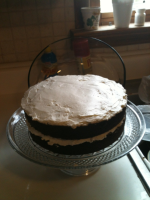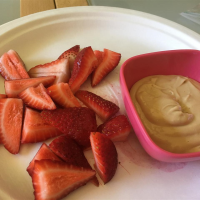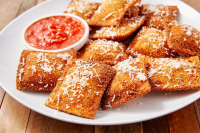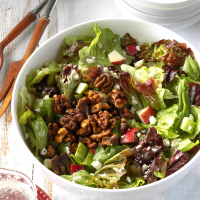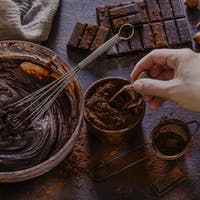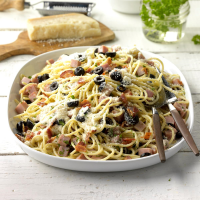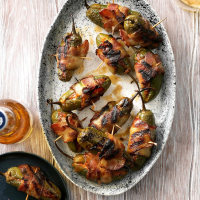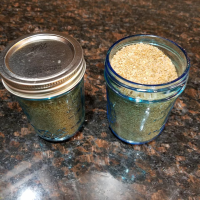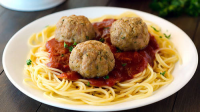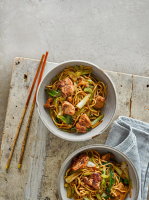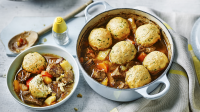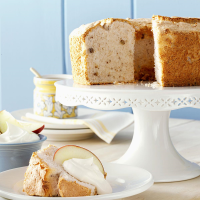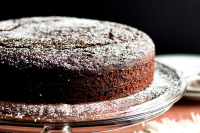STEAMED CUSTARD BUNS RECIPE | PETE AND GERRY'S ORGANIC EGGS
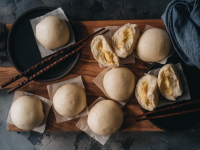
Also known as nai wong bao, custard buns are a dim sum classic Made with a yeast dough and cooked in a steamer, these buns have a super soft and bouncy texture with a smooth surface The custard filling is creamy, fragrant, and sweet, embodying that perfect melt-in-your-mouth texture when eaten warm They lie somewhere between milk bread rolls and cinnamon buns: hearty and filling, but just sweet and creamy enough to pass for dessert, they can be enjoyed during breakfast, as an afternoon snack with tea, or alongside your dinner
Provided by Omnivore's Cookbook
Prep Time 01:00:00
Cook Time 00:20:00
Yield 16 buns
Number Of Ingredients 13
Steps:
- Add water to a small microwave-safe bowl and warm to approximately 100-110F, about 30 seconds in microwave. Add sugar and active dry yeast and let sit for 5 minutes to allow the yeast to activate.
- While the yeast activates, add cake flour and baking powder into the bowl of a stand mixer. When bubbles form on the surface of yeast mixture, add to bowl with the flour and baking powder. Stir with a spatula just until liquid is absorbed by dry ingredients.
- Insert dough hook attachment into mixer. Start kneading at low speed, then gradually increase to medium speed (level 6 out of 10). Let knead for 10 minutes, until dough is very smooth. If needed, stop the mixer halfway through and scrape dough from the sides of the bowl.
- Add shortening to dough and knead on medium speed for another 5 minutes. Dough should be soft, smooth, and easily lift from the bowl without sticking to your hands.
- Lightly grease a large bowl with butter or cooking spray. Transfer dough into greased bowl and cover bowl with plastic wrap. Let rest in a warm part of your kitchen until dough triples in size, about 2 hours.
- While dough rests and rises, combine cornstarch, all-purpose flour, and 1/8 cup sugar in a small bowl. Set aside. In a separate large bowl, whisk egg yolks briefly to break them up.
- In a small saucepan, warm milk and remaining 1/8 cup sugar over medium heat, stirring occasionally to dissolve the sugar completely. Cook until mixture reaches 120F (no higher than 150F). You might see a few bubbles here and there, but if the mixture starts foaming, it’s too hot.
- Just before the milk mixture is to temperature, add cornstarch, flour, and sugar mixture to egg yolks, whisking until a uniform paste forms. Do not add the dry ingredients too early, because the sugar will change the texture of the eggs.
- Add warm milk mixture into egg yolk mixture about 1/4 cup at a time, whisking constantly with each addition until the milk is fully incorporated into the paste. Continue adding and stirring until a thin, smooth mixture has formed and all milk has been added.
- Return mixture back to the the pot used to warm the milk. Heat over medium-low and stir constantly until mixture thickens, about 5 minutes. Custard should be thick enough for you to draw a line on the bottom of the pot using a spatula. The custard will start to thicken suddenly, like a switch was flipped, so keep a very close eye on it. When this occurs, remove from heat immediately and add butter and vanilla extract, then stir to combine.
- Line a large, deep plate with plastic wrap. Place a large mesh strainer on top. Pour custard onto lined plate through the strainer to smooth out the texture. Use a spatula to press custard through the strainer if any lumps remain.
- Cover custard with plastic wrap, pressing the wrap against the custard itself so it won’t form a skin. Chill in the fridge until fully cooled, about 2 hours.
- Cut parchment paper into 16 3” (7 cm) squares to hold the buns. Punch the air out of the dough and transfer it onto a lightly oiled working surface. Knead a few times to form dough into a round ball, then divide into 16 even pieces by cutting it first into 2 even strips, then cutting each strip into 4 small pieces. Each piece of dough should weigh approximately 27 grams.
- Use your hands to roll and shape dough pieces into balls. Working with the dough balls one at a time, flatten each ball using your palm. Then, use a rolling pin to roll the flattened dough into a round disc that is thick in the middle and thin on the edges, about 2.5" to 3” (6 to 7 cm) in diameter.
- Carefully remove rolled dough wrapper from your work surface and place it onto your palm. Drop a heaping tablespoon of custard into the center of wrapper, pressing down gently to release any air bubbles within the custard.
- Use your other hand to gather the wrapper onto the top of custard filling. The wrapper will start to form pleats and retain its round shape. Finally, place the wrapped bun pleated-side-down onto one of the cut parchment squares, then place it on a plate. Set a timer before moving onto the second bun in order to keep track of resting time; ensure that the buns rest 20-30 minutes before steaming.
- Loosely cover buns with plastic wrap to prevent them from drying out as you repeat the process with remaining dough and custard.
- To prepare the steamer, add about 3” (7 cm) of water to the pot and heat over medium-high until water starts to boil. Place rested buns onto steamer rack, leaving at least 2” (5 cm) in between, as the buns will expand during cooking. Cover and let steam for 10 minutes. Once done, remove steamer rack and place onto a trivet. Carefully uncover steamer rack, let steam escape, then transfer buns onto a serving plate. Let buns cool for 5 minutes before eating.
- When making your custard, take care not to overheat the milk, or it will cook the eggs and turn the filling into a lumpy soup. If you do not have a thermometer, heat up the milk over low heat until it’s warm, but not scalding hot to the touch.
- It's important to stir the custard constantly as you heat it up on the stove. The mixture will be very runny at the beginning and will take a few minutes to cook, but once it starts to thicken, everything happens in the blink of an eye.
- Pressed for time? Chill the custard in the freezer for 30 minutes instead of refrigerating. The texture will harden and become easier to work with once chilled.
- Depending on the size of your steamer, you might need to steam the buns in batches. If this is the case, prepare the steamer after wrapping half of the buns so that one batch can steam as you wrap the rest.
- These custard buns taste best when still warm, but can be served at room temperature or stored. To store, let the buns cool completely, then place in a sealed container at room temperature if serving the same day. Buns can also be stored for 2-3 days in the refrigerator. To serve, gently warm the buns in the microwave.
CHINESE STEAMED BUNS RECIPE | ALLRECIPES

Here's some yummy, Chinese dim sum you can make, either plain without meat fillings, or with meat fillings. A wok equipped with a stainless steel steam plate, a plate with holes to allow steam to pass, is required to make these tasty buns. You may use milk in place of the warm water if you wish.
Provided by Carol chi-wa Chung
Categories Bread Yeast Bread Recipes
Total Time 4 hours 0 minutes
Prep Time 30 minutes
Cook Time 30 minutes
Yield 24 steamed buns
Number Of Ingredients 10
Steps:
- Mix together yeast, 1 teaspoon sugar, 1/4 cup flour, and 1/4 cup warm water. Allow to stand for 30 minutes.
- Mix in 1/2 cup warm water, flour, salt, 2 tablespoons sugar, and vegetable oil. Knead until dough surface is smooth and elastic. Roll over in a greased bowl, and let stand until triple in size, about 2 1/2 to 3 hours.
- Punch down dough, and spread out on a floured board. Sprinkle baking powder evenly on surface, and knead for 5 minutes. Divide dough into 2 parts, and place the piece you are not working with in a covered bowl. Divide each half into 12 parts. Shape each part into a ball with smooth surface up. Put each ball on a wax paper square. Let stand covered until double, about 30 minutes.
- Bring water to a boil in wok, and reduce heat to medium; the water should still be boiling. Place steam-plate on a small wire rack in the middle of the wok. Transfer as many buns on wax paper as will comfortably fit onto steam-plate leaving 1 to 2 inches between the buns. At least 2 inches space should be left between steam-plate and the wok. Cover wok with lid. Steam buns over boiling water for 15 minutes.
- REMOVE LID BEFORE you turn off heat, or else water will drip back onto bun surface and produce yellowish "blisters" on bun surfaces. Continue steaming batches of buns until all are cooked.
Nutrition Facts : Calories 44.4 calories, CarbohydrateContent 8.4 g, FatContent 0.7 g, FiberContent 0.4 g, ProteinContent 1.1 g, SaturatedFatContent 0.1 g, SodiumContent 35 mg, SugarContent 1.2 g
More about "mustard steamed buns recipes"
NIKUMAN / BUTAMAN / PORK BUN RECIPE - FOOD.COM
This is a steamed bun with a pork filling. I first tasted this in Japan, it warms you up on a cool day. And served with hot mustard and soy sauce it is perfection. I found this recipe by searching on the internet.
From food.com
Reviews 5.0
Total Time 1 hours
Calories 145.3 per serving
From food.com
Reviews 5.0
Total Time 1 hours
Calories 145.3 per serving
- (makes about 10 nikuman).
See details
STEAMED RECIPES | BBC GOOD FOOD
Make a simple supper or an impressive pudding with out best ever steamed recipes. Create a fabulous fish dish for the whole family or a sweet dessert.
From bbcgoodfood.com
From bbcgoodfood.com
See details
ASIAN STEAMED BUNS WITH BOK CHOY AND CHINESE CHIVES RECIP…
Feb 01, 2019 · In a large bowl, combine the warm water, honey and yeast and …
From foodandwine.com
From foodandwine.com
See details
STEAMED BUNS - MANTOU - RASA MALAYSIA
May 04, 2020 · Traditional Chinese steamed buns or mantou (??) is one of the most popular steamed bun recipes in Chinese food. In this post, you are going to learn the easiest way to make homemade steamed buns or mantou buns. This recipe is so quick, easy and 100% fail-proof.
From rasamalaysia.com
From rasamalaysia.com
See details
STEAMED CUSTARD BUNS (NAI WONG BAO, ???) - RED HOUS…
Aug 06, 2021 · Leave the buns to rest in a warm place to proof for about 30 minutes. During this process, they’ll grow a little bigger (but won’t double) and …
From redhousespice.com
From redhousespice.com
See details
STEAMED CHINESE CUSTARD-FILLED BUNS | TASTE
In a large bowl, whisk together the eggs and sugar until homogeneous. Add the cornstarch and flour; whisk until no lumps remain. Whisk in the milks, butter, and vanilla extract just until combined. Strain the mixture through a fine mesh sieve into an 8x8-inch pan, preferably ceramic or glass. Place the pan into the steamer …
From tastecooking.com
From tastecooking.com
See details
CHINESE STEAMED CUSTARD BUNS (NAI WONG BAO) - JESSICA GAVIN
Feb 16, 2018 · The importance of yeast. Steamed custard buns are made with yeast dough. Fermentation of sugar in the dough by the yeast called Saccharomyces cerevisiae helps the dough to rise. Yeast can be killed at temperatures above 138°F (43°C), so make sure not to add water or milk hotter than directed during fermentation.
From jessicagavin.com
From jessicagavin.com
See details
TAIWANESE GUA BAO | ???? • CHOOCHOO-CA-CHEW
Gua Bao is a cut-open steamed bun stuffed with tender, flavorful braised pork, pickled mustard, peanut powder, and cilantro. You can often find this tasty treat at night markets in Taiwan, it is so good that it has made its way across the globe, starting trends in all big cities.
From choochoocachew.com
From choochoocachew.com
See details
HOW TO MAKE STEAMED MEAT BUN (NIKUMAN) FROM HAIKYU ...
Sep 17, 2021 · Premium meat buns made from premium meats are also available. Sauces for Nikuman. Freshly steamed buns are tasty enough on their own, but there is a custom to eat them with sauce depending on the region. For example, in the Kyushu region, people eat them with vinegar and soy sauce and Japanese mustard paste.
From ninjarecipe.net
From ninjarecipe.net
See details
PORK BELLY BAO RECIPE | FOOD NETWORK
Open up the steamed buns. Spread each with 1/2 tablespoon of the hoisin and then top with a slice of pork belly and 1 tablespoon of the preserved mustard green mixture.
From foodnetwork.com
From foodnetwork.com
See details
EASY JAPANESE STEAMED PORK BUNS (NIKUMAN) RECIPE | THE ...
Place about 1 tablespoon of the ground pork mixture filling in center of each round. Going around and gathering the edges of the biscuit to the center and pinch tightly to seal at the top and forming a 2 inch ball. Place a wax/parchment square on the bottom (non-seam) side of each ball. In a deep skillet or Dutch oven, heat 1/2 to 1 inch water ...
From thejapantry.com
From thejapantry.com
See details
CUAPAO - ANG SARAP
Jul 29, 2020 · Basically it is the same recipe as the normal steamed bun, also called folded steamed sweet buns, Lotus Leaf Buns, bao bun or Guabao. Traditionally it is filled with a slice of red-cooked pork belly , dressed in stir-fried suan cai (pickled mustard greens), coriander, and ground peanuts but in the Philippines the slice of pork belly is replaced ...
From angsarap.net
From angsarap.net
See details
FALL RECIPE: VEGETARIAN STEAMED BUNS | KITCHN
Sep 28, 2011 · Instructions. In a bowl, mix the flour, yeast, baking powder, sugar, and salt together. Add the sesame oil and stir lightly. Slowly mix in the water and stir to combine. Knead the dough on a lightly floured, clean work surface until the dough is smooth, about 5 minutes.
From thekitchn.com
From thekitchn.com
See details
STEAMED BAO BUNS RECIPE (FLUFFY CHINESE BAO) - HUNGRY HUY
Oct 13, 2021 · In a small mixing bowl, combine the milk and oil. Slowly add the liquid into the mixer. Turn up the speed to level 5. When the dough turns into a ball and releases from the sides of the mixing bowl, continue to knead on medium (about level 5) for 5 more minutes. If necessary, scrape down the sides of the bowl.
From hungryhuy.com
From hungryhuy.com
See details
YOU WON'T BELIEVE WHERE STEAMED BUNS CAME FROM - EJJI
May 31, 2017 · Steamed buns originated in Northern China, where wheat, rather than rice was more prominently grown. In fact, there are many legends on exactly how steamed buns came to be. The history of steamed buns originated during the Three Kingdom Period and according to legend, a Chinese general needed to lead his army across a raging river.
From ejjiramen.com
From ejjiramen.com
See details
MCDOG | STEAMED THEN TOASTED DOGGIES - JAHZKITCHEN
McDog Buns. A standard Hot Dog Bun that is buttered and then steamed before being toasted. This creates a soft but crisp Hot Dog Bun. Butter the Buns and then steam them at the same time your Hot Dogs are boiling, if using hot dogs. I use a pizza screen on top and cover with a lid that allows room for the Hot Dog Buns.
From jahzkitchen.com
From jahzkitchen.com
See details
STEAMED RECIPES: BROWSE ALL DISHES - PAGE 3 OF 3 - THE ...
Steamed Dishes. Steamed dishes are just as important in Asian cooking as roasted or baked dishes are in Western cuisine. In this collection of steamed recipes, you’ll find steamed buns, dumplings, and dim sum, but also steamed meat dishes, steamed fish & seafood, and even steamed desserts!
From thewoksoflife.com
From thewoksoflife.com
See details
HOISIN MUSHROOM GUA BAOS (VEGAN RECIPE) - THE FOODIE TAKES ...
Jul 14, 2020 · Gua baos are steamed stuffed buns or bao buns. I think what makes these really distinct is how they face open (like a tacos) unlike the usual steamed pork buns you may see that are twisted and sealed at the top throughout. The gua baos I grew up with were filled with pork belly and usually mustard greens along with some peanuts.
From thefoodietakesflight.com
From thefoodietakesflight.com
See details
GUA BAO (TAIWANESE PORK BELLY BUNS, ??) - OMNIVORE'S COOKBOOK
Oct 14, 2020 · Once the oil is hot add the pork belly. Cook on both sides until the edges just turn golden, then transfer to a plate. Add the garlic, green onions, and ginger to the same skillet. Stir to release the fragrance, about 1 minute. Add the star anise, cinnamon, and chilis. Stir and cook for another 30 seconds.
From omnivorescookbook.com
From omnivorescookbook.com
See details















